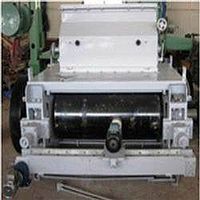Flakers
Flakers are used to compress and flatten a product into a thin and uniform product. The flaking process is very important in achieving the maximum nutritional potential of a feed pellet. Most seeds have tough oil bearing cellular structure which has to be ruptured or weakened prior to cooking and extraction.
Typical Working Principle
The heated weir distributes the product over the steel belt and forms a film that is taken up by the running steel belt. The liquid product solidifies to an even layer on the steel belt, which is cooled by spraying water from the underside. Retaining strips of Neoprene or rubber prevent the product from spilling over the egde of the steel belt. At the cooler end, a crusher breaks the solid product layer into small irregular flakes. After leaving the crusher, the flakes are fed into a chute for further processing.
Common Features
- Variable speed drive arrangement for adjustment of the drum speed for optimum performance
- Suitable for a wide range of chemical and pharmaceutical products
- Contact parts can be stainless steel, carbon steel, and hard chrome plated depending on material requirements
- Accessories include hood, flake breaker, flake conveyor, applicator roller etc
Areas of Applications
- Drug Intermediates
- Stearic Acid
- PNCB
- Endosulphan
- OPDA
- Phosphorus Pentasulphide
- Alcohols
- Phenols/Waxes/Resins
- HCO
- Maleic Anhydride
- Pthaleic Anhydride
- Benzoic Acid
Typical Advantages
- Product has easy to handle flake form.
- Melts with wetting property to metal surface, can be flaked.
- Low power demand
- Continuous operation
- Compact installation
- Closed construction available
- To minimise vapour nuisance
- To avoid dust contamination
- For inert gas blanketing
- For maintenance of suction conditions for purposes of operator comfort.
- For maintenance of low RH air blanket.
Video
